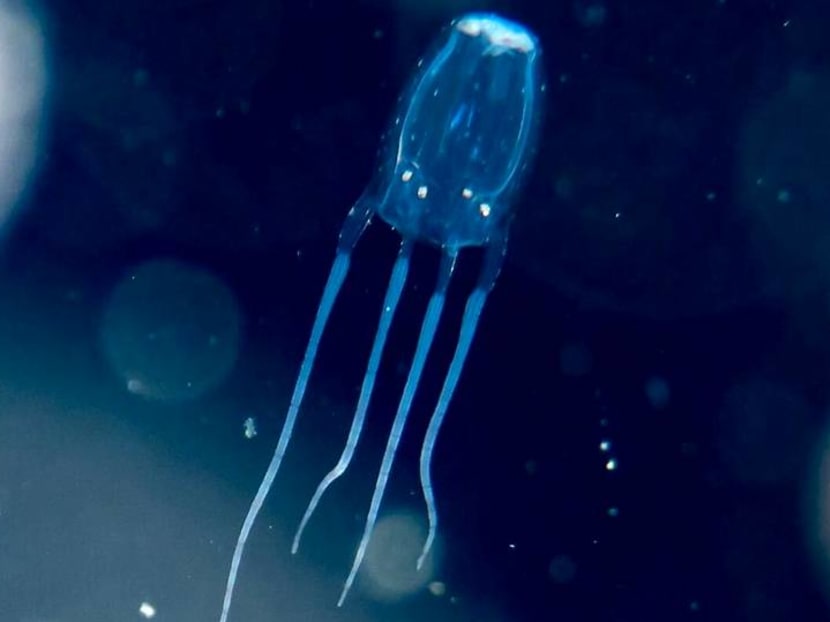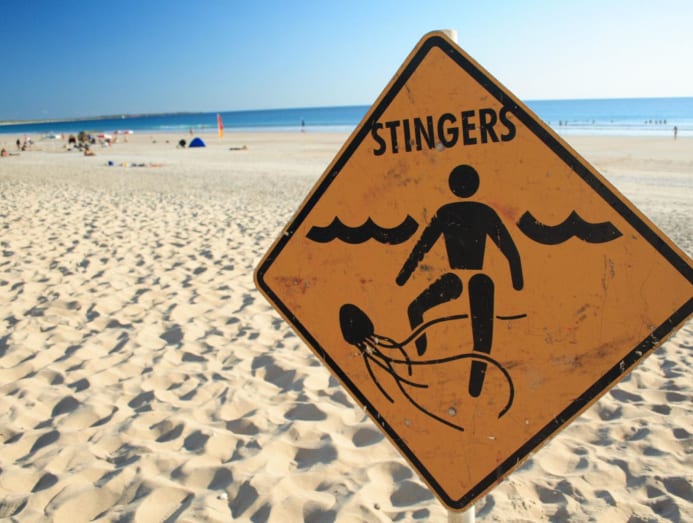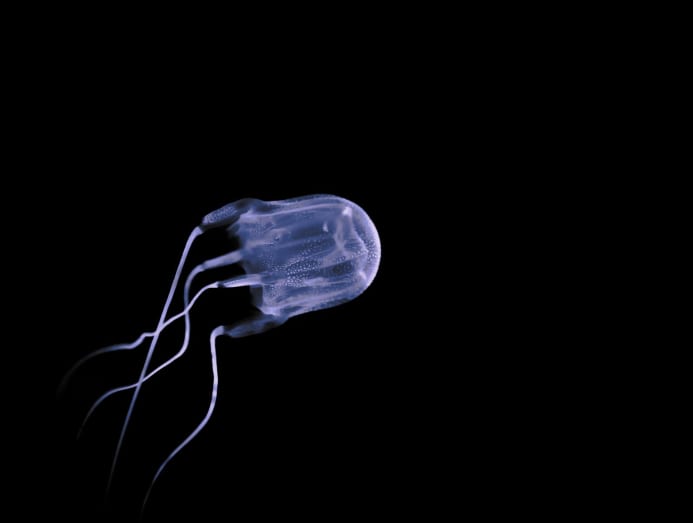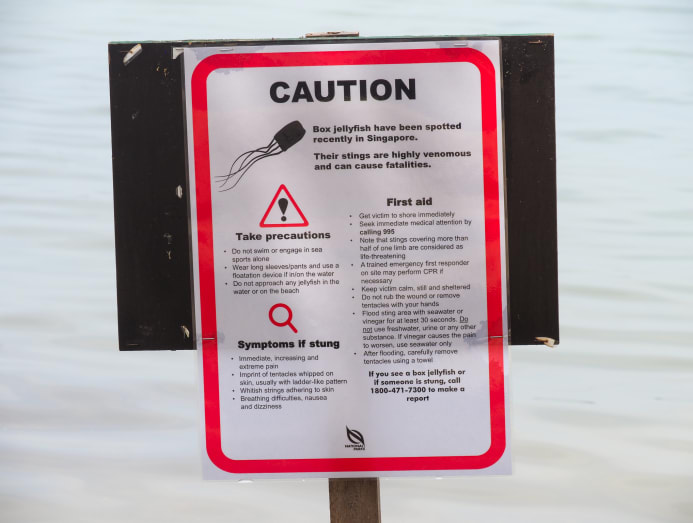My real-life experience with jellyfish stings: What worked and what didn’t
With recent box jellyfish sightings in Singapore, CNA Lifestyle’s Khoo Bee Khim recalls her previous stinging experience in Australia and lists down some handy advice. Calling 995, yes. Peeing on it? Maybe not.

A box jellyfish photographed off the coast of Indonesia in June 2019. (Photo: Wikimedia Commons)
I still remember two things from my brush with jellyfish years ago. First, a horrific pain that felt like the worst caning of my life (yes, I was a naughty child so I do have a benchmark). The second was me shouting at the top of my terrified lungs: “You are not peeing on me!”
I was at a beach at the Gold Coast in Australia, and being the foolhardy student that I was back then, I waded into the water, despite warnings of box jellyfish sightings in the news. I thought: The ocean is so big. Can’t be so unlucky to encounter one, right?
I was proven wrong mere minutes in waist-deep water. A translucent blob the size of a tennis ball drifted a metre or so from me (cue: the Jaws theme track).
I later read that unlike other jellyfish that drift with the ocean’s currents, the box jellyfish actually has eyes and can swim up to a speed of four knots – or the equivalent of 7km/h on land.
But caught between the powerful Pacific Ocean surf and a block of human idiocy that was me, it couldn't swim away.

My exposed thighs bore the brunt of the contact. Instantly, it felt like someone had sliced them with fiery-hot blades, then slashed them again for good measure. My brain was flooded with so many pain signals, specks of white flickered into my view, melded and Liquid-Papered out my vision.
For a few moments, my brain just couldn’t process anything else or react – not even cry out.
After what felt like an eternity in the sea, I hobbled back to the shore crying and with blue, thread-like tentacles still clinging to my thighs.
“Jellyfish! Jellyfish!” I gasped to my friends, in between shock-induced, breath-sucking sobs.

WHAT WORKS, WHAT DOESN’T
Now older and with a day job that entails writing about all things health-related, the recent news about box jellyfish sightings in Singapore’s beaches got me thinking about that day: What I should or shouldn’t have done after being stung.
It’s still not clear to me whether it was the deadly variety or a lesser one (it was the season for box jellyfish though), but either way, I count myself lucky.
Anyway, no one emptied his or her bladder onto me that day – and it turns out, I was right to insist "no thanks".
“There is no evidence to show that peeing on the sting site will help and it may cause more venom to be released,” said Dr Julian Ng, a general practitioner from DTAP Clinic Group.

Forget also about using alcohol, ethanol or ammonia, advised Mayo Clinic. Instead, apply plain vinegar to the area for 30 seconds to deactivate the cells that secrete the venom, said Dr Ng.
“Do not use an ice pack, and do not apply pressure bandages as these may trigger further toxin discharge.”
From experience, fresh water doesn’t lessen the pain either. My friends emptied every receptacle of drinking water onto me but that offered no relief.
As it turned out, fresh water might have triggered the release of more venom if the tentacles were still embedded in the skin, according to Healthline.
Another thing I shouldn’t have done was try to rub the tentacles off my skin. The key, according to Dr Ng, was to pick at it with a towel or gloved hand, not rub or scrape them off.
Rubbing could cause the sting cells to inject even more venom into your body, which certainly made my red, angry welts redder and angrier.

IN HOT WATER
A lifeguard, whom my friend went to get help from, had urged me to get into a hot bath pronto. What? Was he mad? My flesh had already felt like it was melting off my thighs and he wanted me to get into hot water. As if I wasn't in it already, well, figuratively.
The peculiar thing about box jellyfish stings (at least from my experience), is the pain doesn't lessen, even after an hour of being stung.
Beach outing cut short, we hightailed back to Brisbane, an agonising 60 minutes or so drive away. I shouldn't have doubted the lifeguard. It took a while, including hovering over a bathtub of hot water, but finally, sweet relief! Mind you, this only brought down the pain intensity from a 10 to a seven but I took it!
For the same amount of venom, children, by virtue of the fact that they are smaller, are more likely to die.
I later read that hot water can indeed neutralise the venom. Mayo Clinic suggested soaking the affected area for 20 to 45 minutes in water that's 43 to 45 degrees Celsius.
If you don't have a thermometer, the water should feel hot, not scalding, to your hand or elbow. If you've been to the foot soak at Sembawang Hot Spring Park, that's how hot the water should be.
I remember that small bits of tentacles refused to let go of my skin even a few days after the incident, so during that time, some parts of my welts had thin blue strips down the middle. Eventually (make that several months), the crazy, red patterns that looked like a toddler's scribbles faded away.
HOW AM I STILL ALIVE?
So back to Singapore. Should this happen here, call 995 after getting the victim out of the water, advised National Parks (NParks), which noted that “stings covering more than half of one limb are considered life threatening”.

According to NParks, the “severity of symptoms vary with the victim’s condition and degree of stinging”. Depending on the species of box jellyfish, you may experience symptoms “almost immediately or even up to 15 to 20 minutes after being stung”.
It further advised that it’s best to monitor the victim for at least 45 minutes after getting out of the water.
Box jellyfish stings are certainly painful but are they always fatal? As unbearable as the episode was, I was lucky I wasn't stung in the eye or mouth, which would have been more serious, or have life-threatening symptoms such as the ones Dr Ng highlighted below:
- Difficulty breathing or swallowing
- A change in voice
- Feeling generally unwell
- Nauseated or vomiting
- Dizzy or has a headache
- Muscle spasms
“It depends on the amount of venom that the person comes into contact with,” said Dr Ng. “For the same amount of venom, children, by virtue of the fact that they are smaller, are more likely to die.”
He explained that the sting is more likely to cause death if the total estimated length of welts is over 70cm.





